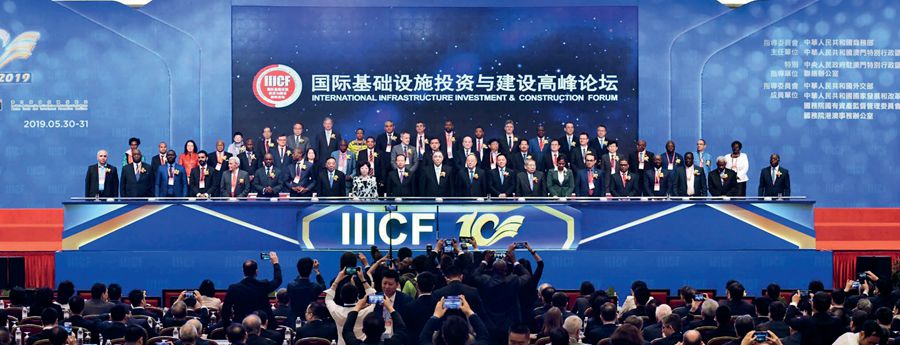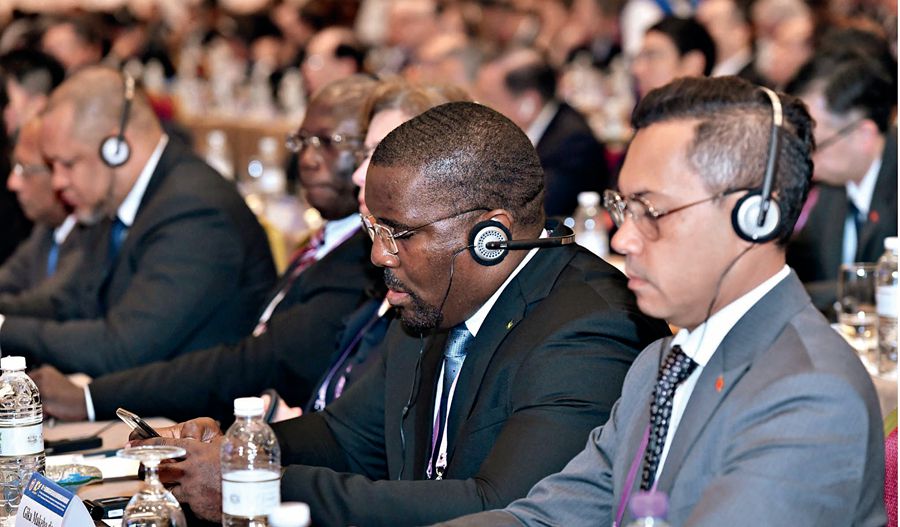THE Belt and Road Initiative has motivated more Chinese enterprises to participate in international cooperation on infrastructure construction and the economic development of host countries. So far, the worth of their engineering contracts abroad has added up to US $2.3 trillion, and their business turnover totaled US $1.6 trillion.
When speaking at the 10th International Infrastructure Investment and Construction Forum on May 30, Vice Commerce Minister Wang Bingnan disclosed that over the past decade, Chinese contractors of engineering projects abroad created 700,000 jobs in host countries, and that China’s financial institutions provided more than US $300 billion in financing to international cooperation on infrastructure development. The focus of the forum, which was attended by more than 2,000 people from 72 countries and regions worldwide, was the sustainable development of global infrastructure.
Ending Low Bidding
The UN 2030 Agenda for Sustainable Development lists building resilient infrastructure as one of its 17 sustainable development goals and targets. In his speech at the opening of the Second Belt and Road Forum for International Cooperation in late April, Chinese President Xi Jinping said that infrastructure is the bedrock of connectivity, and highlighted the importance of high-quality, sustainable, resilient, affordable, inclusive, and accessible infrastructure projects for a country’s development.

The 10th International Infrastructure Investment and Construction Forum opens on May 30, 2019 in Macao.
Liew Mun Leong, chairman of Changi Airport Group of Singapore, blamed the defects of some infrastructure projects on lowball bids of contractors. With meager budgets, the contractors inevitably cut corners in the construction. Consequently when choosing bids, price should not be taken as the most important factor. It is also true that high quality doesn’t always come at high cost.
Zhu Xian, vice president and chief operations officer of the New Development Bank, agreed, saying that the contractor offering the lowest price in bidding may not deliver the highest quality or the best returns. He therefore suggested making a systematic analysis of cost based on the entire life cycle of a project, with its maintenance and operation also factored in.
Chen Qihua, vice president of Caterpillar responsible for the China Operations Division, explained that a high-quality project is a project that is sustainable over its entire life cycle instead of just for a short period of time. He called for globalized cooperation in project design and construction, and emphasized the importance of integrating the concepts of environment-friendliness and green development in the whole process to ensure a project’s sustainability.
Joachimvon Amsberg, vice president of the Asian Infrastructure Investment Bank (AIIB), stressed the importance of international standards. There are many international standards at present, for instance, for bidding and environmental protection. They are welcomed by all parties: Regional governments understand that the projects meeting international standards can boost local economic development; and contractors understand observance of these standards can prevent rigged bidding. International standards are therefore important for sustainable investment. The AIIB, so far with 97 members, has funded 39 projects in 15 countries. Amsberg said that quality and sustainability are key factors in its assessment of projects.
From Freehand to Fine Brushwork
At a meeting commemorating the fifth anniversary of the Belt and Road Initiative last year, Chinese President Xi Jinping said, “In the past years we have completed the overall planning for the initiative, painting a grand work with broad freehand strokes. In the coming years we will focus our attention on key areas and details, producing a work of fine brushwork.” With the metaphor of two vastly different traditional Chinese painting techniques, the president emphasized the high quality and sustainability of infrastructure of this ambitious initiative.
“A high-quality, sustainable infrastructure project must be one of vitality and values, including economic value, environmental value, social value, and governance value,” said Du Chunguo, general manager of PowerChina Resources Limited. He gave the Qasim coal-fired power plant of Pakistan as an example, of which PowerChina is a co-investor. The plant generates one-tenth of the total power supply of the country; has maintained smooth operation despite 14 grid collapses last year. Its cost is low and its profits high. By April of this year, it had contributed US $240 million in taxes to local coffers.

Officials, businesspeople and scholars of more than 70 countries and regions participate in the forum.
According to Du, his company planted 125 acres of mangrove trees around the plant to preserve the surrounding terrestrial and littoral eco-systems, maintains sulfur and nitrogen oxides emissions below the level the World Bank mandated for gas-powered power stations, and uses desalinated sea water to minimize consumption of fresh water. As of its social value, the project opened up 4,000-plus jobs in addition to creating employment indirectly for close to 10,000 people in the country.
In the opinion of Julian Vella, Asia Pacific regional director for KPMG’s global infrastructure practice, a sustainable infrastructure project should be sustainable environmentally, economically, operationally, and socially throughout its life cycle, perform its functions well with consistency, and bring benefit to local communities and residents in the process.
Banji Oyelaran-Oyeyinka, special adviser on industrialization to the president of the African Development Bank (AfDB), stressed the importance of top-level design for infrastructures to ensure their quality and sustainability. He believed that Africa needs to enhance connectivity with the rest of the world as well as that between regional countries, so as to accelerate trade across the continent.
This view was echoed by Shi Jiyang, vice chairman of the board and president of China-Africa Development Fund (CADF). Shi observed that a key factor that impedes manufacturing in Africa is electricity shortage, and that connectivity is the precondition for China-Africa cooperation under the Belt and Road Initiative. “This connectivity covers ports, airports, aviation, telecommunications, an information expressway, and an international trade payment and settlement system between the two sides. To facilitate China-Africa trade and investment, developed infrastructure in these areas is very important,” he said.
Diversified Financing Sources
The Belt and Road Infrastructure Development Index Report 2019, released by the China International Contractors Association and China Export and Credit Insurance Corporation, finds that the cost of infrastructure development in Belt and Road countries, including operational costs and financing costs, is rising. This year’s report looks at the development environment, needs, costs, and trend of the infrastructure sector in 71 countries.
Honson To, chairman of KPMG Asia Pacific, pointed out that the funds and resources of public departments of Belt and Road countries can hardly meet the needs for local infrastructure investment; it is therefore important for them to attract private capital globally. Though China has made huge contributions to narrowing the world’s infrastructure investment gap, it cannot accomplish this mission on its own. According to To, in its surveys and studies, KPMG has found that private international investors are willing to participate in the construction and operation of infrastructures in Belt and Road countries. Chinese businesses need to cooperate with these investors to make up for the capital shortfall, and what’s more important, learn from their management expertise, engineering technologies, financing patterns, and operational experience. Thereby they can deliver more successful infrastructure projects.
The World Bank’s PPI Database tracked a marked increase in private investment in infrastructures in Belt and Road countries during 2017, growing by 64.7 percent year on year to US $62.14 billion.
In To’s opinion, governments, businesses, multinational organizations, and professional institutions of specific fields should join hands in improving the institutional capacity and risk control capacity of Belt and Road countries, so that private international investors can feel a stronger sense of security and belonging, and get more involved in infrastructure construction and operation in these countries.

